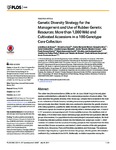Please use this identifier to cite or link to this item:
http://www.alice.cnptia.embrapa.br/alice/handle/doc/1035994| Title: | Genetic diversity strategy for the management and use of rubber genetic resources: more than 1,000 wild and cultivated accessions in a 100-Genotype core collection. |
| Authors: | SOUZA, L. M. de  LE GUEN, V.   CERQUEIRA-SILVA, C. B. M.   SILVA, C. C.   MANTELLO, C. C.   CONSON, A. R. O.   VIANNA, J. P. G.   ZUCCHI, M. I.   SCALOPPI JUNIOR, E. J.   FIALHO, J. de F.   MORAES, M. L. T. de   GONÇALVES, P. de S.   SOUZA, A. P. de   |
| Affiliation: | JOSEFINO DE FREITAS FIALHO, CPAC. |
| Date Issued: | 2015 |
| Citation: | Plos One, San Francisco, v. 10, n. 7, e013607, 2015. |
| Description: | Abstract - The rubber tree [Hevea brasiliensis (Willd. ex Adr. de Juss.) Muell. Arg.] is the only plant species worldwide that is cultivated for the commercial production of natural rubber. This study describes the genetic diversity of the Hevea spp. complex that is available in the main ex situ collections of South America, including Amazonian populations that have never been previously described. Genetic data were analyzed to determine the genetic structure of the wild populations, quantify the allelic diversity and suggest the composition of a core collection to capture the maximum genetic diversity within a minimal sample size. A total of 1,117 accessions were genotyped with 13 microsatellite markers. We identified a total of 408 alleles, 319 of which were shared between groups and 89 that were private in different groups of accessions. In a population structure and principal component analysis, the level of clustering reflected a primary division into the following two subgroups: cluster 1, which consisted of varieties from the advanced breeding germplasm that originated from the Wickham and Mato Grosso accessions; and cluster 2, which consisted of the wild germplasm from the Acre, Amazonas, Pará and Rondônia populations and Hevea spp. The analyses revealed a high frequency of gene flow between the groups, with the genetic differentiation coefficient (GST) estimated to be 0.018. Additionally, no distinct separation among the H. brasiliensis accessions and the other species from Amazonas was observed. A core collection of 99 accessions was identified that captured the maximum genetic diversity. Rubber tree breeders can effectively utilize this core collection for cultivar improvement. Furthermore, such a core collection could provide resources for forming an association panel to evaluate traits with agronomic and commercial importance. Our study generated a molecular database that should facilitate the management of the Hevea germplasm and its use for subsequent genetic and genomic breeding. |
| Thesagro: | Hevea Brasiliensis |
| Keywords: | Natural rubber Estrutura genética Genetic structure |
| DOI: | 10.1371/journal.pone.0134607. |
| Type of Material: | Artigo de periódico |
| Access: | openAccess |
| Appears in Collections: | Artigo em periódico indexado (CPAC)  |
Files in This Item:
| File | Description | Size | Format | |
|---|---|---|---|---|
| Josefinogeneticdiversity.pdf | 3.18 MB | Adobe PDF |  View/Open |









